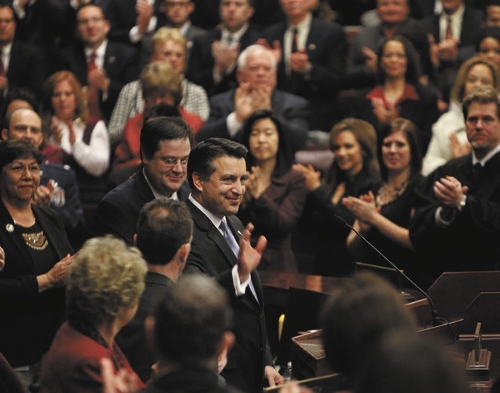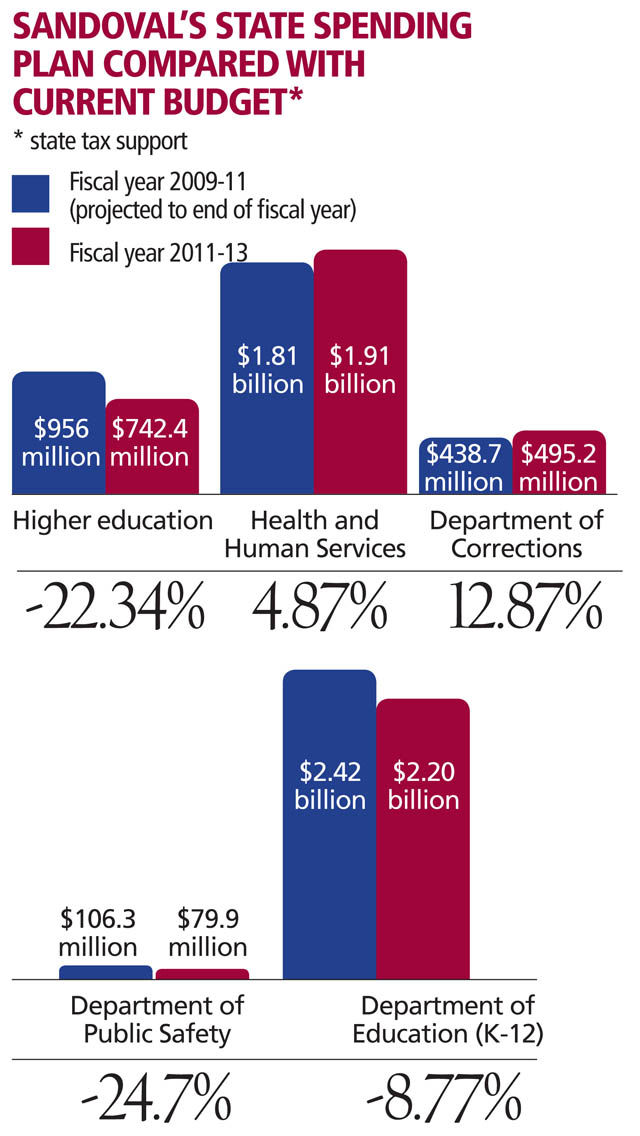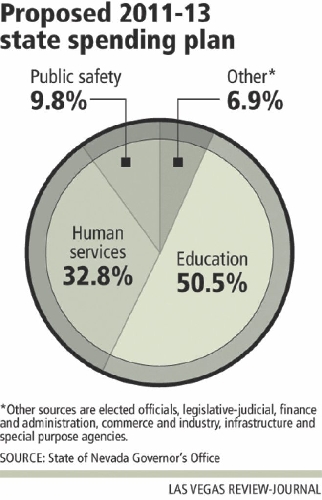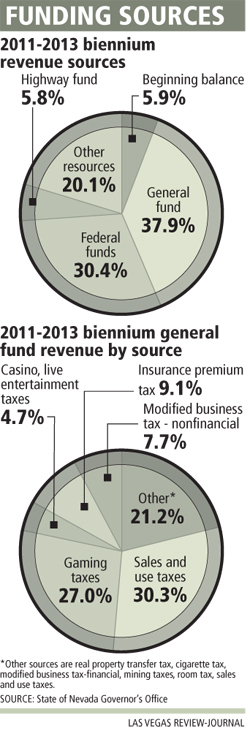Sandoval calls for cuts to revive state
In his first State of the State address, Gov. Brian Sandoval on Monday promoted new economic development, major education reform and government consolidation to revive Nevada and create jobs as he proposed a $5.8 billion budget that makes deep cuts, eliminates 19 agencies and shifts more burden to counties for social services.
Sandoval called some of his short-term solutions to the state's financial crisis painful, but said he was setting a "fundamental course correction" that's necessary because Nevada's population growth has stalled, its jobless rate is the highest in the nation and raising taxes now to increase government spending would hurt businesses and Nevadans he's trying to help.
"Some believe government is the only solution to our current plight," Sandoval said, addressing Nevada lawmakers during a televised address inside the Assembly chambers in Carson City. "I disagree. Unemployment, foreclosures, bankruptcy -- the cure is not more government spending but helping businesses create jobs. The key is to get Nevada working again."
The speech sets Sandoval's agenda and goals for his first term and comes just ahead of the Democratic-led Nevada Legislature, which begins meeting on Feb. 7 for 120 days to review his budget proposal and come up with its own plan.
Although the Republican governor made a pitch for lawmakers to set aside partisan fights, state Senate Majority Leader Steven Horsford made it immediately clear he would lead Democrats in battle against cuts to education, saying the governor's budget was dead on arrival. Sandoval's proposal to end teacher tenure is expected to be a major battleground as well.
Horsford, flanked by 12 other Democratic legislators, including Assembly Speaker John Oceguera, said Sandoval's proposed spending cuts are too drastic. Horsford wants to maintain education funding at current levels.
"I will not process a budget as proposed that cuts education in this manner," said Horsford, who suggested corporations could be tapped to help come up with extra-money solutions. "The business community needs to be a part of it."
Sandoval's hourlong speech, blandly delivered with few rhetorical flourishes, was met with mostly mild but frequent applause -- more than 50 times -- from some 400 lawmakers, their families, lobbyists, gaming leaders such as Steve Wynn and Treasure Island chief Phil Ruffin as well as conservative and liberal activists and citizens. Special guests ranged from Michelle Rhee, a controversial education reformer from the nation's capital, to a decorated state trooper who got a standing ovation.
It was a highly choreographed start to an unpredictable legislative session that will not only deal with the state budget battle but also with the political lightning rod issue of redrawing the state's Senate and Assembly districts and the congressional district outlines after Nevada was awarded a fourth House seat because its population rose to about 2.8 million people.
"In past sessions, I could probably predict 80 percent of what was going to happen, but in this one I have no idea," said former Democratic Speaker Richard Perkins, now a lobbyist who watched the speech. "There is so much uncertainty and there are larger issues at play, from taxes to redistricting to education reform. It's anybody's guess how it will turn out."
Sandoval proposed a budget plan for 2011-13 that sets the state back to 2007 spending levels, submitting a general fund budget of $5.8 billion, or 6.4 percent less than current spending -- not as deeply cut as feared by critics.
He balanced his budget by suggesting a total of $1.6 billion in spending cuts, including a 5 percent salary reduction for state workers, teachers and professors; a near 9 percent cut in K-12 spending; a 22 percent cut to higher education, while allowing universities to raise tuition to make up the difference; and elimination of 824 state jobs out of a total 24,494 by merging and consolidating agencies, which in a worst case scenario could lead to layoffs of up to 361 current workers.
Although the governor held to his pledge not to propose new taxes, he found $1 billion in additional revenues to fill the gap in his general fund. About half those revenues came from so-called "reallocations," including the two biggest items: $220 million in room tax collections that were supposed to go into a fund for teacher raises and $190 million in insurance premium taxes that won't be collected for several years, but against which the government will borrow for now.
The two other major revenue shifts Sandoval used to balance the general fund come from continuing the diversion of a 9-cent property tax collection to help pay for $121 million in higher education costs and from proposing a legal change that will allow schools to use as operating funds $425 million in reserves that had been set aside for the repayment of bond debt.
Sandoval also shifted some social services responsibilities from the state to county governments, including for child welfare, youth parole, emergency medical services and some mental health programs.
In his budget plan, Sandoval called for an overhaul of the state's economic development program, increasing its budget by 50 percent and working more with the private sector to create jobs. He suggested launching a $10 million "catalyst fund" to offer businesses incentives to re-locate to Nevada. He also proposed another $10 million for an effort to hire people who have been jobless for a long time or who are veterans or low income and need more help finding work.
Sandoval addressed Nevada families in his speech, but at times also aimed it at people and businesses from out of state.
"My message tonight is one of opportunity -- certainly for Nevadans who care about our economic growth -- but also for those listening outside our state," said Sandoval. "Nevada is a place you can call 'home' and 'headquarters' with equal measure."
Assembly Speaker Oceguera, the Democrat who delivered a pre-taped 15 minute response, congratulated Sandoval on his address and said he wished him success. He was careful to note the Democrats agree with the new GOP governor on many issues -- a stark contrast to the confrontational relationship they had with former Republican Gov. Jim Gibbons.
Yet Oceguera also made it clear the Democrats believe Sandoval isn't spending enough to improve the education system, both schools and higher education, which Nevada leaders believe is key to luring new businesses.
"We can rebuild Nevada," Oceguera said. "But we cannot expect businesses to invest in Nevada if we aren't willing to invest as well. Our ability to grow new jobs paying a decent wage depends on an educated work force."
Without being specific, Oceguera suggested Democrats were ready to back taxes and fee hikes or new levies.
"We know it's never a good time to raise taxes," Oceguera said, but added, "as the governor said, it is a time for shared sacrifice."
Senate Majority Leader Horsford set aside diplomatic niceties and rejected Sandoval's budget head-on, suggesting that during the session he may play Democratic bad cop to Oceguera's good cop in negotiations.
Horsford said he agreed with Sandoval that lawmakers must work with him on economic development and to get Nevadans back to work, but he said the governor "offered a budget that would gut public education -- and our kids' futures as a result."
"This means laying off literally thousands of teachers and closing entire college campuses," Horsford said, putting the most dire face on the proposed cuts. "It means we cannot afford real reform to our schools or come even close to a tolerable level of funding for higher education -- the engine of a new economy. In short, this budget would dismantle public education."
Sandoval's education initiatives included cutting teacher and professor salaries by 5 percent and ending teacher tenure. He also wants to end "social promotion" of students to higher grades and to give parents greater school choice, including providing vouchers to private schools.
"Our education system is broken," Sandoval said. "Not the people, but the system."
Review-Journal reporter Benjamin Spillman contributed to this report. Contact Laura Myers at lmyers@reviewjournal.com or 702-387-2919.
Gov. Sandoval's first State of the State speech
Democratic response to State of the State speech
2011-2013 Executive Budget


























